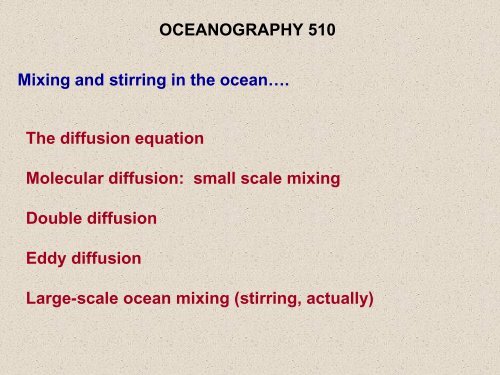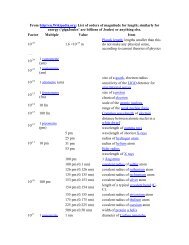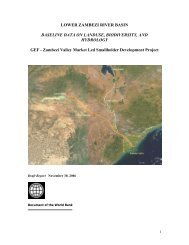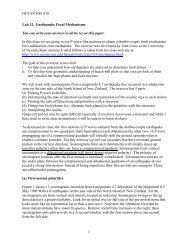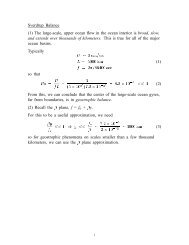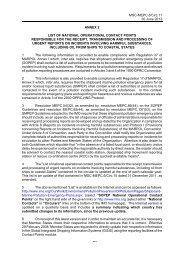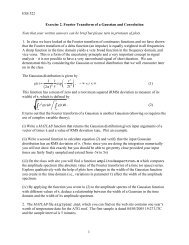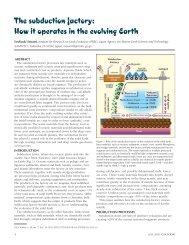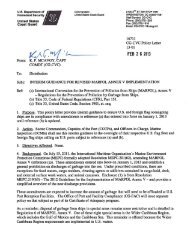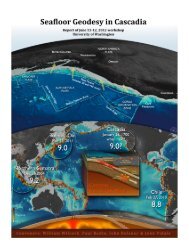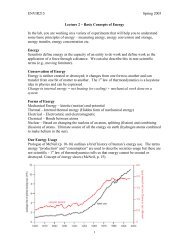Mixing and stirring in the oceanâ¦. The diffusion equation Molecular ...
Mixing and stirring in the oceanâ¦. The diffusion equation Molecular ...
Mixing and stirring in the oceanâ¦. The diffusion equation Molecular ...
Create successful ePaper yourself
Turn your PDF publications into a flip-book with our unique Google optimized e-Paper software.
OCEANOGRAPHY 510<strong>Mix<strong>in</strong>g</strong> <strong>and</strong> <strong>stirr<strong>in</strong>g</strong> <strong>in</strong> <strong>the</strong> ocean….<strong>The</strong> <strong>diffusion</strong> <strong>equation</strong><strong>Molecular</strong> <strong>diffusion</strong>: small scale mix<strong>in</strong>gDouble <strong>diffusion</strong>Eddy <strong>diffusion</strong>Large-scale ocean mix<strong>in</strong>g (<strong>stirr<strong>in</strong>g</strong>, actually)
Diffusion: basic questions….clear fluid + red dye = p<strong>in</strong>k waterForward problem: describe mix<strong>in</strong>gInverse problem: describe circulation[<strong>in</strong>itial value problem?]What is mix<strong>in</strong>g? What is <strong>stirr<strong>in</strong>g</strong>?
<strong>The</strong> <strong>diffusion</strong> <strong>equation</strong>….δzF x1F x2M[Flux <strong>in</strong>, x] [Flux out, x]δyδxzy∂M∂t= Flux <strong>in</strong> −Flux outx
<strong>The</strong> <strong>diffusion</strong> <strong>equation</strong>….∂M = [ F δx1 y δ z − F δx2 y δ z ] + [ F δy1 x δ z − F δy2x δ z ]∂t+ [ F δxδy−F δxδy]z1 z21 ∂M ( F (1 2)1 2)x− F Fx y− Fy( Fz1−Fz2)= + +δxδyδz ∂t δx δy δz1 ∂M ∂C= −∇ ⋅ F =V ∂t ∂t[C = concentration]
<strong>The</strong> <strong>diffusion</strong> <strong>equation</strong>….1 ∂M ∂C= −∇ ⋅ F =V ∂t ∂tchange of concentration of C <strong>in</strong>side <strong>the</strong> cubedivergence of <strong>the</strong> flux through <strong>the</strong> cubeIt is necessary to relate <strong>the</strong> concentration C to<strong>the</strong> flux F <strong>in</strong> order to make fur<strong>the</strong>r progress.
<strong>The</strong> <strong>diffusion</strong> <strong>equation</strong>….(i) Flux due to advection, F ASuppose <strong>the</strong> velocity vector at <strong>the</strong> center of <strong>the</strong>cube is u = (u, v, w). <strong>The</strong>n <strong>the</strong> advective flux of Cthrough <strong>the</strong> cube is uC .Check <strong>the</strong> units:⎡L⎤⎡amount of stuff ⎤ ⎡amount of stuff ⎤F A = uC ~ ⎢=3 2⎣T⎥⎢ ⎦⎣ L ⎥⎦⎢⎣ LT ⎥⎦[<strong>the</strong> units of a flux]
<strong>The</strong> <strong>diffusion</strong> <strong>equation</strong>….<strong>The</strong> complete <strong>diffusion</strong> <strong>equation</strong> becomes∂C∂t= −∇ ⋅ ( F + F ) = −∇ ⋅ ( uC)+ κ∇CA D or∂ C +∇⋅ ( uC)= κ ∇∂t2C2
<strong>The</strong> <strong>diffusion</strong> <strong>equation</strong>….Assum<strong>in</strong>g that <strong>the</strong> fluid is <strong>in</strong>compressible,∇⋅ ( uC) = C∇⋅ u+ ( u⋅∇ ) C = ( u⋅∇)C ∂C ∂C ∂C= u + v + w∂x ∂y ∂zSo <strong>the</strong> <strong>diffusion</strong> <strong>equation</strong> becomesdCdt2= κ∇ C + sources & s<strong>in</strong>ks
<strong>Molecular</strong> <strong>diffusion</strong>….Lam<strong>in</strong>ar motion: smooth <strong>and</strong> direct flow,weak <strong>in</strong>ertia, relatively viscousTurbulent motion: confused flow, <strong>in</strong>direct,strong <strong>in</strong>ertia, relatively <strong>in</strong>viscidLam<strong>in</strong>ar motion:molecular <strong>diffusion</strong>Diffusivities are known.(see tables)κ T = 10 -3 cm 2 /secκ s = 10 -5 cm 2 /secκ u = 10 -2 cm 2 /sec ≡ νA measure of <strong>the</strong> relative size of viscous <strong>and</strong> <strong>in</strong>ertialforces is <strong>the</strong> Reynolds number (Re), given byRe<strong>in</strong>ertial forcesviscous forces2⋅∇ ⎛U⎞ ⎛υU⎞ 2 ⎜ ⎟ ⎜ 2 ⎟u u UL= =υ∇ u ⎝ L ⎠ ⎝ L ⎠ υ
<strong>Molecular</strong> <strong>diffusion</strong>….Re = Reynolds number = <strong>in</strong>ertial/viscous = UL/υLam<strong>in</strong>ar flows: low ReTurbulent flows: high ReExperimentally, it has been found that <strong>the</strong> transitionbetween <strong>the</strong>se states occurs around Re ~ 3000.[ 2000 – 4000 ]Re ~ UL/υ ≤ 3000 → L ≤ (3000υ)/U = (3000)(0.01)/3L ≤ 10 cmcm 2 /secOn scales of a few centimeters or less, <strong>the</strong> flow is lam<strong>in</strong>ar,with property gradients smoo<strong>the</strong>d by molecular <strong>diffusion</strong>.On larger scales, <strong>the</strong> flow is turbulent, with propertygradients smoo<strong>the</strong>d by eddy <strong>diffusion</strong>.cm/sec
Example: molecular <strong>diffusion</strong> associated with <strong>the</strong>stratification of <strong>the</strong> ocean....<strong>The</strong> ocean is stratified <strong>in</strong> both temperature <strong>and</strong> sal<strong>in</strong>ity,which can lead to some unexpected difffusive effects.This is known as double <strong>diffusion</strong>.Consider 3 dist<strong>in</strong>ct cases:(i) Warm, fresh water overly<strong>in</strong>g cold, sal<strong>in</strong>e water.zIn <strong>the</strong> absence of any forc<strong>in</strong>g,T <strong>and</strong> S gradients will diffuseaway <strong>and</strong> <strong>the</strong> ocean will becomehomogenized (both gradientsare stable).ST
<strong>Molecular</strong> <strong>diffusion</strong>….(ii) Warm, sal<strong>in</strong>e water overly<strong>in</strong>g cold, fresh water.T is stabliz<strong>in</strong>g,S is destabiliz<strong>in</strong>g.If T stratification is <strong>in</strong>itiallystronger, no direct convectionis possible.Suppose <strong>the</strong>re is some length scale L associated with<strong>the</strong> stratification, <strong>and</strong> a diffusive time scale τ.2 2L L τTκSκ ⇒ τ ⇒ 10τ κ τ κSzTTS−2
<strong>Molecular</strong> <strong>diffusion</strong>….2 2L L τTκSκ ⇒ τ ⇒ τ κ τ κST10−2Result: T gradients will diffuse away <strong>in</strong> 1% of <strong>the</strong>time required to diffuse <strong>the</strong> S gradients. <strong>The</strong> rema<strong>in</strong><strong>in</strong>gS gradient will be unstable, <strong>and</strong> overturn<strong>in</strong>g will occur.This phenomenon is known as salt f<strong>in</strong>ger<strong>in</strong>g.
An example ofdouble <strong>diffusion</strong>(f<strong>in</strong>ger<strong>in</strong>g)produced <strong>in</strong> alaboratory, takenfrom Turner,Buoyancy Effects<strong>in</strong> Fluids.50 cm
F<strong>in</strong>ger<strong>in</strong>g on an <strong>in</strong>terface (from Turner)2.5 cm
<strong>The</strong> horizontal structureof laboratory salt f<strong>in</strong>gers,from Turner, BuoyancyEffects <strong>in</strong> Fluids.5 cm
(iii) Cold, fresh water overly<strong>in</strong>g warm, sal<strong>in</strong>e water.zS is stabiliz<strong>in</strong>g,T is destabiliz<strong>in</strong>g.S<strong>The</strong> T stratification will disappearfirst. If <strong>the</strong> T gradient is strongenough, overturn<strong>in</strong>g might occur.Eventually molecular <strong>diffusion</strong>will remove <strong>the</strong> sal<strong>in</strong>ity gradient.T
Turbulent <strong>diffusion</strong>….Turbulent flows are irregular <strong>and</strong> confused.<strong>The</strong> ocean is turbulent on all scales larger than a few cm.It is still possible to use <strong>the</strong> <strong>diffusion</strong> <strong>equation</strong>(flux/gradient arguments might still hold), but we canno longer use <strong>the</strong> molecular diffusivities.<strong>The</strong> concept of a turbulent diffusivity is only aparameterization of <strong>the</strong> turbulence; essentiallywe are replac<strong>in</strong>g <strong>the</strong> molecular value with a muchlarger one, but assum<strong>in</strong>g <strong>the</strong> process of <strong>diffusion</strong>generally rema<strong>in</strong>s <strong>the</strong> same.[<strong>the</strong> “eddy diffusivity”]
Turbulent <strong>diffusion</strong>….Eddy diffusivities are usually many orders ofmagnitude larger than <strong>the</strong>ir molecular counterparts.Example: temperature <strong>in</strong> water (molecular) ~ 10 -3 cm 2 /secVertical <strong>diffusion</strong> <strong>in</strong> <strong>the</strong> ocean, κ z ~ 0.01 – 1 cm 2 /secHorizontal <strong>diffusion</strong> <strong>in</strong> <strong>the</strong> ocean, κ x ~ 10 6 – 10 8 cm 2 /secNote: <strong>in</strong> <strong>the</strong> turbulent case <strong>the</strong> eddy diffusivities might bedifferent <strong>in</strong> different directions, s<strong>in</strong>ce <strong>the</strong> processesresponsible for <strong>the</strong> mix<strong>in</strong>g might differ along coord<strong>in</strong>ate axes.Example: stratification is different vertically <strong>and</strong> horizontally<strong>in</strong> <strong>the</strong> ocean.
Turbulent <strong>diffusion</strong>….[note: for variable κ x this is∂∂x⎛⎜κx⎝∂C∂x⎞⎟⎠etc.]dCdt=∂2∂2∂2κ∇ 2C → κ + κ + κx 2 y 2 z 2[lam<strong>in</strong>ar]C C C∂x ∂y ∂z[turbulent]<strong>The</strong> diffusivity is now a tensor <strong>in</strong>stead of a scalar.
Turbulent <strong>diffusion</strong>….<strong>The</strong> full time-dependent, nonl<strong>in</strong>ear, turbulent <strong>diffusion</strong><strong>equation</strong> has no general solution. Instead, considersome tractable problems that have been simplified.Example: Munk’s model of <strong>the</strong> oceanic <strong>the</strong>rmocl<strong>in</strong>e.Steady; only vertical <strong>diffusion</strong> is allowed; uniformupwell<strong>in</strong>g is present.upward advectionof cold waterfrom below∂T∂Tw∂ z= κz2z2∂>0 >0 >0 >0downward<strong>diffusion</strong> of heatfrom above[see Munk, “Abyssal recipes”, 1966]
Turbulent <strong>diffusion</strong>….∂T∂T2w∂ z= κzz2∂→2d T ⎛ w ⎞dT− ⎜ ⎟ =dz ⎝ ⎠02κ dzz[if w <strong>and</strong> κ z are constants]<strong>The</strong> solution to this ODE is of <strong>the</strong> formzT(z)( ) ( )e( w / κz) zT z = T − T + TS D DT Ssurface temperaturedeep temperatureT D
Turbulent <strong>diffusion</strong>….z/zoS D D oT( z) = ( T − T )e + T , z =κzwIn recent years κ z has been found to be ~ 0.1 cm 2 /secover much of <strong>the</strong> ocean <strong>in</strong>terior. For <strong>the</strong> N. Pacific,<strong>the</strong> scale height z o can be taken to be ~ 600 m.This suggests that w ~ (0.1)/(6x10 4 ) ~ 10 −6 cm/sec .[small <strong>and</strong> unmeasurable]
Measur<strong>in</strong>g turbulent <strong>diffusion</strong>….In 1993, Ledwell <strong>and</strong>colleagues releaseda small patch of dyeat a depth of 300 m <strong>in</strong><strong>the</strong> N. Atlantic<strong>the</strong>rmocl<strong>in</strong>e; <strong>the</strong>y wereable to follow this dyefor over half a year.231<strong>The</strong> degree of dispersion of <strong>the</strong> dye is related <strong>the</strong> turbulent diffusivity.
Turbulent <strong>diffusion</strong>….Vertical profiles through<strong>the</strong> dye show that <strong>the</strong> dyespreads vertically <strong>in</strong> time,as would be expected formix<strong>in</strong>g.<strong>The</strong> rate of spread<strong>in</strong>g isproportional to <strong>the</strong> verticaleddy diffusivity, κ z .
Turbulent <strong>diffusion</strong>….••<strong>The</strong> rate of verticalspread<strong>in</strong>g of <strong>the</strong> dyecan be used toestimate <strong>the</strong> eddydiffusivity from asimple model.••
Turbulent <strong>diffusion</strong>….Simple advection-<strong>diffusion</strong> models can also beused to exam<strong>in</strong>e horizontal diffusive processes.Example: <strong>the</strong> 3 He plume <strong>in</strong> <strong>the</strong> S. Pacific
Turbulent <strong>diffusion</strong>….• • •• •••∂H∂H2U∂ x= κ xx2∂Lupton <strong>and</strong> Craig, 1981
Turbulent <strong>diffusion</strong>….Float dispersionshows <strong>the</strong>character ofturbulence <strong>in</strong> <strong>the</strong>western N. Atlantic<strong>the</strong>rmocl<strong>in</strong>e700 m<strong>The</strong> plot shows <strong>the</strong> positions of 18 floats after one year.
Turbulent <strong>diffusion</strong>….Float dispersion atsub-<strong>the</strong>rmocl<strong>in</strong>elevels of <strong>the</strong> N.Atlantic1300 m18 floats after one year, 1300 m
AuWiEddy k<strong>in</strong>eticenergy by seasonat 900 m <strong>in</strong> <strong>the</strong>western N. Atlantic,<strong>in</strong>ferred from floatdispersion.Sp[units: (cm/sec) 2 ]Suκ xκ y[units: 10 7 cm 2 /sec]
1000 mPacific float dispersion: anisotropic
[units: ergs/g][ (cm/sec) 2 ]Eddy k<strong>in</strong>etic energy <strong>in</strong> <strong>the</strong> Pacific
Atlantic•<strong>in</strong>terior°•westernboundary°Pacific• ZONAL° MERIDIONALEddy diffusivity estimates scale roughly as EKE
Transient tracers <strong>and</strong> mix<strong>in</strong>g….Tracers can beused with aknowledge of<strong>the</strong>ir sources <strong>and</strong>s<strong>in</strong>ks todeterm<strong>in</strong>ecirculation <strong>and</strong>mix<strong>in</strong>g<strong>The</strong> history of CFC, 1930s - 2000
σ θ = 26.0Us<strong>in</strong>g <strong>the</strong> measuredvalues of CFC-11 <strong>and</strong>CFC-12, it is possibleto determ<strong>in</strong>e <strong>the</strong> ageof a water mass (ie,<strong>the</strong> time s<strong>in</strong>ce it left<strong>the</strong> sea surface) <strong>and</strong>to <strong>in</strong>fer pathways <strong>and</strong>strengths of mix<strong>in</strong>g<strong>and</strong> circulation.σ θ = 26.4[from Warner et al., 1996]
Oxygen <strong>in</strong> <strong>the</strong> ocean….Dissolved oxygen has a ubiquitous m<strong>in</strong>imum at mid-depth<strong>in</strong> <strong>the</strong> world ocean….why?
Diffusion of dissolved oxygen….biological consumptiondCdt=2 2 2∂ C ∂ C ∂ Cκ + κ + κ + Rz ( )x 2 y 2 z∂x ∂y ∂z2Note that <strong>the</strong> m<strong>in</strong>imum at mid-depth occursnearly everywhere. If we average <strong>the</strong> oxygen<strong>diffusion</strong> <strong>equation</strong> over <strong>the</strong> entire global ocean,<strong>and</strong> assume a steady state, we f<strong>in</strong>dw∂C∂ z=2Cκ ∂ + Rz ( )z∂z2O 2 : R(z) ∼ e αzRadioactive tracers:R(z) = −λC
Boundary conditions: C=C 1 at z=z 1 ; C=C 2 at z=z 2 ….[ Note: R(z) = R o e αz typically ]a typical solution


